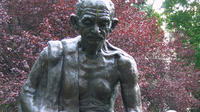Mahatma Gandhi and Satyagraha Private Tour of Johannesburg
Johannesburg, South Africa
Rating: 





Trip Type: Private Sightseeing Tours
Duration: 8 hours
Inspiring and informative, this tour traces the steps of Mahatma Gandhi during his time in Johannesburg, from his first arrival in the south of Johannesburg to central Johannesburg, where a plethora of buildings mark Gandhi’s influence. Visit landmarks of potent historical value that created the spark of the Satyagraha movement.
More About This Activity All Private Sightseeing Tours →
Inspiring and informative, this tour traces the steps of Mahatma Gandhi during his time in Johannesburg, from his first arrival in the south of Johannesburg to central Johannesburg, where a plethora of buildings mark Gandhi’s influence. Visit landmarks of potent historical value that created the spark of the Satyagraha movement.Inspiring and informative, this tour traces the steps of Mahatma Gandhi during his time in Johannesburg, from his first arrival in the south of Johannesburg to central Johannesburg, where a plethora of buildings mark Gandhi’s influence. Visit landmarks of potent historical value that created the spark of the Satyagraha movement. Travel to Johannesburg and embark on a brief and general city orientation tour. Stop at Hamidia Mosque, made famous as the site where Mohandas Gandhi led the first burning of passes on August 16, 1908. On that date, 3,000 Muslims, Hindus and Christians led by Gandhi, a Hindu, gathered in the courtyard of the Hamidia Mosque and burned their passes. A memorial has been built outside the mosque to commemorate this event.
Continue to Museum Africa, which is Johannesburg’s social and cultural history museum. It is located in what was once the city’s fruit and vegetable market, with a block-long facade, towering pillars and huge interior space. Its long-term exhibitions of social history include is Gandhi’s Johannesburg, birthplace of Satyagraha. The Gandhi exhibition shows the buildings and places associated with Mahatma Gandhi and his struggle against discrimination, and encourages visitors to go to the sites described in the museum. Proceed to Constitution Hill where Gandhi was imprisoned four times in South Africa. The "Prisoner of Conscience" exhibition commemorates the life of Gandhi and touches on his experiences while in prison.
Continue to Satyagraha House, in a residential neighborhood of Orchards in Johannesburg, which was the home of Mohandas Gandhi from 1908 to 1909. Within these walls, the future Mahatma created and developed his philosophy of passive resistance, or "Satyagraha" in Sanskrit, a pacifist method of protest that he employed in India to lead the country to independence. A museum retracing Gandhi’s experiences in South Africa, and particularly those that he shared here with his friend Kallenbach, is installed in the very heart of the house. In this way, a peaceful and meditative atmosphere channeling Gandhi’s life within these walls inhabits the property.
At the end your visit, return to your hotel by late afternoon.
Continue to Museum Africa, which is Johannesburg’s social and cultural history museum. It is located in what was once the city’s fruit and vegetable market, with a block-long facade, towering pillars and huge interior space. Its long-term exhibitions of social history include is Gandhi’s Johannesburg, birthplace of Satyagraha. The Gandhi exhibition shows the buildings and places associated with Mahatma Gandhi and his struggle against discrimination, and encourages visitors to go to the sites described in the museum. Proceed to Constitution Hill where Gandhi was imprisoned four times in South Africa. The "Prisoner of Conscience" exhibition commemorates the life of Gandhi and touches on his experiences while in prison.
Continue to Satyagraha House, in a residential neighborhood of Orchards in Johannesburg, which was the home of Mohandas Gandhi from 1908 to 1909. Within these walls, the future Mahatma created and developed his philosophy of passive resistance, or "Satyagraha" in Sanskrit, a pacifist method of protest that he employed in India to lead the country to independence. A museum retracing Gandhi’s experiences in South Africa, and particularly those that he shared here with his friend Kallenbach, is installed in the very heart of the house. In this way, a peaceful and meditative atmosphere channeling Gandhi’s life within these walls inhabits the property.
At the end your visit, return to your hotel by late afternoon.
« Go Back

